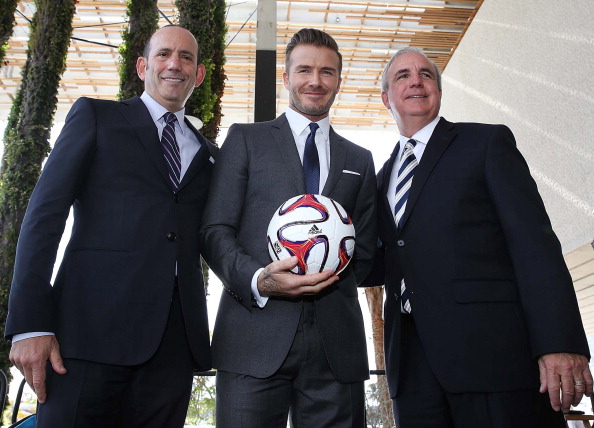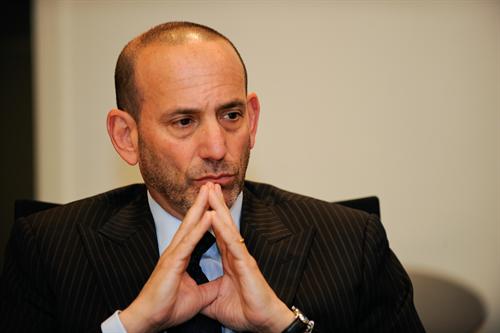Thank everything that’s holy in American soccer, because David Beckham has finally untangled his stadium mess in Miami. Goldenballs, the man treated as soccer’s messiah, he of the pleasing facial symmetry and golden locks – now deftly swept backward and to cover up a top-secret bald spot at his head’s apex. He has finally found a little land in the rundown Overtown neighborhood, where he can build shelter and birth a Major League Soccer team.
After two oceanfront sites and another by Marlins Park fell through – mostly over political, well, politicking and the Beckham ownership group’s attempts to extract some public financing and/or tax breaks on the real estate – he has bought some land and can apparently proceed to actually digging a hole and putting some building materials in it.
No, wait. First the county commissioners have to approve the deal and sign off on the re-zoning. Then the sale has to close, which isn’t expected to happen until February. Then Miami Beckham United, which is what the group is really called, must presumably get some financing arranged – even if it’s private, as they’ve always claimed it would be. And then they’ll probably have to get building permits, like every other shmo trying to fling up a 30,000-seat stadium in the downtown metropolis.
Still, “We have never been closer,” MBU crowed in a statement. Sadly, this is true.
“We are very supportive of Miami Beckham United’s plans to locate their stadium in the City of Miami’s Overtown neighborhood,” MLS Commissioner Don Garber said in a statement. “Their vision for a world-class venue within the urban core that is accessible by mass transportation is impressive, and we believe it will be an important part of the continued revitalization of the area.”
Never mind that it was the fourth-choice venue.
Beckham announces Overtown site for soccer stadium https://t.co/sxK3heMPKG via @newsbysmiley @doug_hanks #mlsmiami pic.twitter.com/dMfAk9aHkC
— Mary Keel (@305green) December 5, 2015
In the very same statement, Garber and MLS also announced plans to expand to 28 teams in the coming years, rather than going to 24 by 2020 and then capping it for a while. “There is no shortage of demand for MLS expansion teams and we believe the opportunity exists to grow beyond our current plans,” Garber said. “We will evaluate how to grow the league to 28 teams and establish a process and timeline for future expansion.”
MLS, as ever, will be cautious on which markets it expands into. In his State of the League conference call just a few days before the announcement, Garber had recalled his early days with MLS, when the two Florida teams had to be contracted just to save the entire league from going under. That was 2002, not so terribly long ago. Oh, and of course last winter the league finally pulled the plug on Chivas USA, which proved to have the wrong owner, the wrong business plan, and the wrong market for said wrong owner and wrong business plan.
Garber spoke at length about the importance of getting Miami right, especially since the Miami Fusion, situated in nearby Ft. Lauderdale, went under after just four seasons. “And frankly, expansion decisions are decisions we live with for a lifetime,” Garber said. “We want to get it right.”
A lifetime. Or whenever you decide that Chivas USA was a mistake and bail out.
http://gty.im/457905956
All the same, Garber has understood for a long time that the trick to getting an MLS team running right is to put a stadium in the middle of a populous area with at least a moderate interest in live sports. That’s why, so long as you can pull together an ownership group with a decent amount of money, the key to landing a team is the stadium. And that’s invariably complicated.
“It’s very difficult overall to be the last league in and to start developing major urban projects after there’s been generations and generations of buildings for all the other leagues,” Garber said. “It’s just the world we live in. I will say the Miami project has been frustrating. It frankly isn’t any more frustrating than some of the other ones we’ve worked on. These things take time.”
The league has been doing its due diligence, and of the four cities favored to take up spots 25 through 28 – the next four expansions have already been awarded to Miami, Saint Paul-Minneapolis, Los Angeles and Atlanta – all have some kind of stadium arrangement lined up.
Sacramento has an ambitious stadium plan ready to go. The city of San Antonio has already acquired the venue the minor league Scorpions play in with an eye towards building it out for MLS. St. Louis had approved stadium plans and funding ready to go in an earlier attempt to land a team. The Las Vegas city council approved public funding for a stadium a year ago.
Yet every time MLS grows, it raises questions about overexpansion. No other professional soccer league in this country has survived for terribly long, after all. And moving past that number, 24, seems a particularly loaded proposition, as that’s the size the NASL was when the wheels came off the whole besotted thing.
In 1977, the old National American Soccer League seemed to have turned a corner. Yet six of its 18 teams remained weak and probably better cut than retained. Still, going against the advice of a committee, the owners decided to add six teams, rather than cut that same number. It was plainly a play for the $3 million expansion fees.
When the bottom fell out of the economy in the early 1980s, the teams – who were mostly losing money as it was, and spent almost all of their revenue on quickly inflating player salaries – tumbled like dominoes. It resulted in a fire sale. And at one point, just about every team was up for sale with owners rushing the life boats off the sinking ship.
The questions, then, are justified, even if MLS has taken pains to develop a business model that runs counter to the one – if there even was one – employed by the NASL in every way, growing tortuously and spending carefully, with tight controls on salaries. But at the same time, six teams have joined since 2010, and at least four more are likely to come on before 2020. That’s almost a doubling of the league’s numbers in a mere decade.
And so we circle back to that awful precedent set by the last fully professional league in this country and its overexpansion. If MLS is overstretching, it might be now. It will be hard to tell for many years if the growth is sustainable or if we are in the midst of a second soccer boom – which, like all booms, will someday go bust.
There are some concerning signs. While the next round of invitations look like they’ll be extended to owners and markets that have their acts together, the teams either newly welcomed in or getting ready to join the league now are, taken in sum, a bit of a shambles. Even though stadium deals are supposed to be a prerequisite for MLS membership, four new franchises lack one. And Atlanta will share a stadium with an NFL team which, no matter how cleverly it’s designed, is a formula that has long since been proved deficient.
Which, of course, brings us back to Miami.
http://gty.im/498207826
There are many suitable descriptors for its pursuit of a stadium – none of them printable. Los Angeles’s second team isn’t anywhere close to locking down a venue. Minnesota took seven months to announce its deal after it had been awarded a team in March. And NYCFC, which has already begun play, could be stuck in Yankee Stadium for years to come.
It begs the question if in this fevered frenzy of nine-figure expansion fees, which almost all of these new “investor-operators” have paid into the single-entity system, MLS may be getting a tad sloppy. If things are being rushed.
If MLS is indeed inflating something of a bubble, these coming years might prove the halcyon days before it pops.








